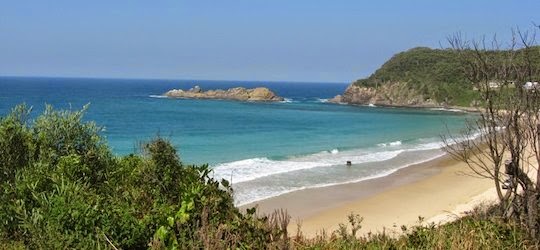
How could indigenous Australians, climate change and the New Testament gospels possibly be connected?
But there really is a connection. So please read on!
The history of the first Australians
More than 50,000 years ago, people first found there way to Australia by boat from Indonesia. Gradually they moved south and east, and some reached the beautiful eastern coast of Australia and established their lives and nations.
They lived there for tens of thousands of years, enjoying an ample food supply from land and sea. Middens (piles of discarded shells, bones, etc) can still be seen up and down the east coast.
The first Australians had no written language, but passed on their lore using songs, dances, stories and rock paintings. Their songlines might tell of where waterholes could be found in desert areas, or where food could be found through the seasons. Ancient “dreaming” (or “dreamtime”) stories might explain how certain landscape features were formed or the meaning of certain tribal customs.
Historical climate change
The last glacial period (ice age) ended about 12,000-20,000 years ago. As the ice sheets around the world melted, the sea level began to rise, reaching something like its present level about 6,000 years ago.
The rising water flooded coastal land and set up geomorphic processes of sedimentation, and new ecosystems, that are still adjusting and developing today. Newly submerged river valleys gradually filled with sediment and lagoons and wetlands gradually formed.
All this took place during the time that aboriginal peoples lived along the east coast of Australia.
The response of aboriginal people
Australia’s indigenous people are very conscious of the land, and the boundaries between nations are clearly defined. They are also very conscious of seasons – where within their land it is best to be at certain times of the year to draw on the available natural resources of food, water and materials. So these changes must have made an impact on their way of life, with some traditional land being lost to the encroaching sea, and some ecosystems changed or lost.
And now comes a report that linguists and a geographer have identified a number of ancient stories that record or remember these huge changes. Some examples:
- some “describe times when dry land occupied space now submerged by water”,
- others “tell of wading out to islands that can now only be reached by boat”,
- “tribes described a time when Port Phillip Bay (near Melbourne) was mostly dry land – tribal descendants recall when “Plenty catch kangaroo and plenty catch opossum there” – recalling a time more than 8,000 years ago,
- the Ngarrindjeri people tell stories of when (more than 10,000 years ago) it was possible to walk to Kangaroo Island near Adelaide,
- similarly tribal stories remember when islands off the west coast near Perth (8,000 years ago) and near the Great Barrier Reef in Queensland (more than 12,000 years ago) were also connect to the mainland,
- the Narrangga people’s stories recall when Spencer Gulf was once a floodplain lined with freshwater lagoons (more than 10,000 years ago).
A surprise for the linguists
The report says that without using written languages, these Australian tribes passed memories of life before, and during, post-glacial shoreline inundations through hundreds of generations as high-fidelity oral history. Linguist Nicholas Reid says:
It’s almost unimaginable that people would transmit stories about things like islands that are currently underwater accurately across 400 generations.
“There are aspects of storytelling in Australia that involved kin-based responsibilities to tell the stories accurately,” Reid said. That rigor provided “cross-generational scaffolding” that “can keep a story true.”
Information transmission in oral cultures
Experts have studied oral cultures around the world and found that they can preserve important information accurately. It isn’t uncommon for there to be clear processes and responsibilities within the community to preserve the important cultural information. Kenneth Bailey, who has studied oral cultures in the Middle East, describes “a carefully rehearsed methodology of great antiquity that is still practised and held in high regard”.
Oral transmission and the New Testament gospels
Scholars generally believe that the gospels were written or compiled between 30 and 70 years after Jesus’ death. While they believe some of the stories and teachings were written down at the time they happened, many of them were handed down by word of mouth for that period of several decades.
Some sceptics argue that this makes the stories suspect – they say they could easily have been forgotten or altered. However scholars have found some evidence that Jesus used teaching methods that aided memorisation, and it seems likely that the early christians used controlled oral transmission (“a carefully rehearsed methodology”) to preserve the stories accurately. Some historians argue that oral transmission, with its community checks, was more accurate than written transmission of documents requiring regular hand-copying.
The transmission of aboriginal stories over 400 generations is not really comparable to the more precise preservation of gospel stories over one generation, but these latest findings show that oral transmission can be far more reliable than modern people may think.
Later addition
Here is another article on the same topic, this time by the researchers.
Picture: Beach at Seal Rocks, NSW. You can find this location on Google Maps. 20,000 years ago, this beach wasn’t there, this area would have been a small valley, and the coast would have been something 10 km further east.